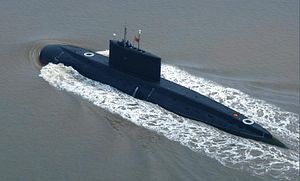Last year, Sri Lanka managed to cause a good deal of trepidation in New Delhi when a Chinese submarine, Changzheng-2, was spotted docking in Colombo, flanked by a Chinese warship. Observers took the visit as a sign that China “has its sights set on dominating the Indian Ocean.” Still, the submarine visit put Sri Lanka in a bit of an awkward position diplomatically with New Delhi. One important detail of the entire incident that did not make it into mainstream reporting was that the sub did not dock in a Sri Lanka-controlled port facility designed to accommodate military vessels. Instead, the submarine ended up at the Colombo South Container Terminal (CSCT), a facility controlled by a Chinese developer. While that facility was able to accommodate the submarine, the entire incident may have taken place without the express approval of the Mahinda Rajapaksa government.
Still, these details aside, Sri Lanka has now taken a firm stand against any perceptions that it is offering preferential port access to Chinese military assets. On Saturday, speaking in Beijing, Sri Lankan Foreign Minister Mangala Samaraweera noted that Sri Lanka would not allow visits by Chinese submarines to its ports. “I really don’t know under which sort of circumstances that led to some submarines… to [visit] the port of Colombo on the very day the Japanese Prime Minister was visiting Sri Lanka. But we will ensure that such incidents, from whatever quarter, do not happen during our tenure,” Samaraweera noted. Samaraweera’s comments suggests that China may not be the only country affected as part of the new government’s plans to ban submarine visits.
The Rajapaksa government’s complicity in inviting the submarine and warship remains somewhat ambiguous. The Sri Lankan government, at the time, embraced the visit, likely to avoid perceptions that the Chinese vessels had docked a Chinese-company controlled facility without the full knowledge of the Sri Lankan government. “A submarine and a warship have docked at Colombo harbour. They called on Oct. 31 and will be here for five days for refuelling and crew refreshment,” noted a spokesman for the Sri Lankan navy, adding that “This is nothing unusual. Since 2010, 230 warships have called at Colombo port from various countries on goodwill visits and for refueling and crew refreshment.”
Following Samaraweera’s statements in Beijing, the Chinese foreign ministry came out in defense of its actions last year. Foreign Ministry spokesperson Hua Chunying told the press that China “had the consent of the Sri Lanka side in advance.” Noting that the Chinese submarine and warship were on their way to an anti-piracy operation in the Gulf of Aden, off the southwestern tip of Arabian peninsula, Hua added that “these are normal and transparent activities. It also followed the international practices,” she said. “It is to my knowledge that policy of Sri Lanka side is to support the global anti-piracy campaign. It welcomes the docking of submarines from the friendly countries,” she added.
Samaraweera, who is foreign minister in the government of Maithripala Sirisena, Rajapaksa’s successor, made the statement in a hope to ease tensions in New Delhi and Tokyo alike about growing Chinese influence in the Indian Ocean. Sirisena, in his election campaign manifesto, had made statements critical of the former Sri Lankan government’s treatment of China. Instead, his manifesto noted that Sri Lanka would not offer preferential economic or security access to any one country, but equally develop its strategic relations with all major Indian states. Notably, the manifesto did not identify any special role for India in Sri Lanka foreign policy, despite the close proximity and historical relationship between the two countries. Samaraweera’s comments in Beijing come shortly after Sirisena completed his first official visit to New Delhi, celebrating a “new beginning.”
The Sri Lankan foreign minister’s trip to Beijing will also lead to a broader China-Sri Lankan bilateral dialogue on the state of Chinese loans in Sri Lanka. Sirisena’s government is concerned with high interest rates tied to an outstanding $5 billion in Chinese loans and will send its finance minister to discuss the issue with China later this year. His government revisited the issue of China’s $1.4 billion investment in the Colombo Port City development project shortly after coming to power, citing environmental concerns. Despite its hesitations, Colombo decided to move ahead with the project.

































